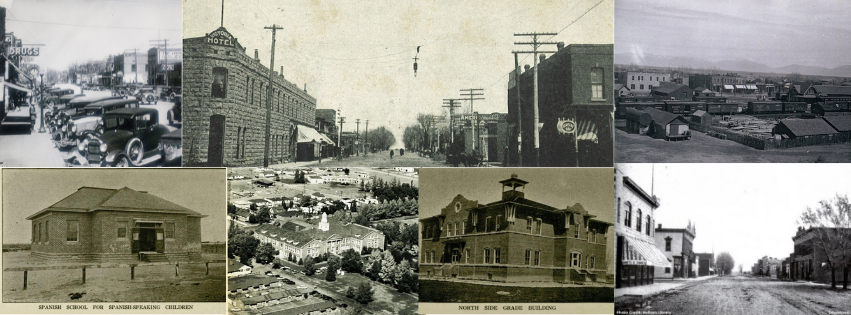Being that Alamosa was named USA Today's Readers Choice 'Best Small Town Cultural Scene' in 2024, we thought it only right to walk you through the history of Alamosa in an exciting blog series highlighting the history and culture of Alamosa dating back from prehistoric records all the way to present day Alamosa. Alamosa's initial culture was formed by the Native Americans and evolved as early settlers arrived in the area! So stick around, this kick off to the series encapsulates thousands of years of history, and it is just the beginning!
The history of the San Luis Valley can be traced back to before written history. Over 11,000 years ago, two prehistoric Native American tribes, Clovis and Folsom, gathered in the area to hunt. Considered to be the longest standing inhabitants of the area, the Ute people began to settle in the area as well. By 1400 A.D., the Apache, Navajo, Tiwa, Tewa, Comanche, Kiowa, Cheyenne, and Arapaho tribes had also taken residence in the area. Over time, clashes between these tribes and the Comanches led to the Valley being unsettled for a great deal of time. It wasn't until Zebulon Pike was exploring the southern part of the Louisiana Purchase that the glorious view of the Great Sand Dunes caught his eye, and he was taken back by its beauty in the year 1807, that the area was recognized again.
Up until Mexico’s liberation from Spain in 1821, the San Luis Valley was claimed by Spain. The Mexican republic then offered land grants to help increase the settlement rates. The grant was taken and broken up into parcels as part of the Amarilla Land Grant, combined with the Conejos Guadalupe Land Grant, broke the area into three counties: Rio Grande,Conejos, and Saguache. After the separation, 50 families from New Mexico created Guadalupe, the first permanent settlement since the early Native Americans.
The 1850’s brought in a steady flow of settlers. Gold and Silver discovery near Summitville fueled the rate of settlement in the Valley. Hopeful prospectors came from all over the place hoping to hit it big panning for gold. The town of Del Norte, founded in 1872 was a resupply hub for the miners. More mining settlements began to form including sites at Creede and Bonanza.
By the year 1876, Colorado was founded as the 38th state. Just one year after the declaration, the construction of the Denver and Rio Grande Railway was beginning to form in the San Luis Valley. Arms of the railway were designed to reach Antonito, Durango, Monte Vista, and Del Norte. Later, another connection was added with the intention to reach Espanola, New Mexico linking a line to trade in Santa Fe. The mass expansion of the railroads helped the boom of mining in the area and ultimately led to the founding of Alamosa. In the year of 1878, a Narrow Gauge train loaded with excited, expectant settlers made its way into the small community, shaded by a cottonwood grove. This gave the town of Alamosa its name, meaning cottonwood grove in Spanish.
More than just the passengers, this train carried the first buildings that would establish the town. In tow were two hotels: The Occidental Hotel and the Broadwell House as well as the Gem Saloon. These buildings were uprooted and transferred from Garland City because the owners of the establishments saw bigger and better opportunities ahead in Alamosa. The Broadwell House served breakfast in Garland City that morning and after being transferred, was set up and ready to serve dinner to eager patrons the same day. The Gem Saloon held a similar story as they served refreshments to the miners in Garland City that morning, and were slinging drinks to the new citizens of Alamosa that evening.
While all of this is happening, the boom of the locomotive industry also contributed to the spread of agriculture in the area. By 1880, Mormon settlers began to make their way into the area and were responsible for the establishment of Manassa, Sanford, and Richfield. These settlers were some of the first farmers in the area and grew many things including barley, peas, alfalfa, and oats. Being that they settled near the Conejos River, and the contribution of the rich solis in the area allowed for successful harvests. By the 20th century, more arms were built onto the railroad to allow agricultural produce to be hauled and sold or traded.
Trains continued to deliver lumber, agricultural products, and hardware and throughout the next ten years, railroads were laid in all four directions making Alamosa the center of the San Luis Valley. In the year 1921, Adams State College was established as a teaching college in Alamosa. Two grade schools had been established in the area by this time as well, the North Side Grade Building and the Spanish School for Spanish-Speaking Children. These establishments outdated the founding of the College by more than ten years however. By 1925, Alamosa had become the ‘city’ of the San Luis Valley. It is where one would go to buy clothing, see a doctor, get a haircut, watch a movie, get a photo taken, or even attend the occasional circus that would be set up in town. Alamosa was thriving by the year of 1930 and had a bustling Downtown featuring a movie theater, clothing stores, hotels, grocery stores, and so much more! development would continue to soar in the coming years.







